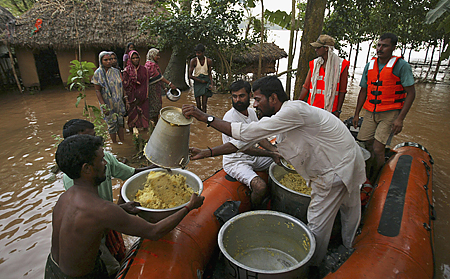
National Disaster Response Force (NDRF) personnel distribute food to villages marooned by floodwaters at Balipatna village, in Kendrapada district, about 150 kilometers (94 miles) from Bhubaneshwar, India, Tuesday, Sept. 27, 2011. (Photo: Biswaranjan Rout / AP)
With at least 5.5 million people affected by flooding in Pakistan and 2 million in India, monsoon floods on the Subcontinent sometimes seem like a grim annual ritual. But on a recent visit to Bihar, I found some surprising evidence that there are simple ways to reduce the vulnerability of even the poorest communities.
Rameshesh, a 15-year-old from Khuta in northern Bihar, proudly shows off a map of his village painted in bright colors on a white cloth, put together by members of a local children’s group. There are about 800 people living in Khuta, and each house is marked according to a key – black triangular shapes for the simple thatch dwellings, and red rectangles for the sturdier concrete ones. Many of them are marked with colored dots, indicating households that would need the most help — those with pregnant women, children with absent parents or older people. There is a red dotted-line near the center encircling the “danger zone” for the region’s annual monsoon flooding, and another symbol to mark the location of the community’s new emergency shelter.
(SEE: Photos of the recent floods in India, which have displaced 2 million.)
Updated every year before the monsoon, this simple map is one of several recent efforts made to reduce the vulnerability of India’s poorest people to natural disasters. Khuta, for example, lies on the northern bank of the Kosi River, and much of it lies near or below the level of the river basin, making it supremely vulnerable to seasonal monsoon floods. After the 2008 Bihar floods, in which more than 2.5 million Indians were displaced, the international child rights’ group Save the Children and its local partner the Kishan Vikash Trust started working in Bihar in villages like Khuta. The change is most visible in the confidence of children like Rameshesh. “We don’t feel scared because we know what to do,” he says. “We’re prepared.”
The emergency shelter is the heart of Khuta’s disaster preparedness, but also of the community itself. The people here are extremely poor, many of them eligible for the Indian government’s work-guarantee scheme, so the community decided collectively to use their subsidized work-days to raise and level a plot of land close to the river bank, where the shelter was built. Raised on stilts and painted a cheerful blue and red, it is easily visible from a boat on the Kosi – the only way to reach Khuta. It looks like a big, brightly wrapped gift, and in a sense that’s exactly what it is. It doubles as the village school, and the community kitchen can be rented out for a fee for weddings and other celebrations.
Those fees help pay for its maintenance and the administration of a grain bank – a storeroom on one of the upper floors is reserved for large sacks of grain to be used in emergencies. Hariram Paswan, 40, like most of his neighbors, lost his home and everything he owned in the 2008 floods. That motivated him to join the grain bank, in which families can choose to contribute a fixed amount of grain every week from their earnings to the grain bank. He pulls out a well-worn passbook, recording that his family of seven has put aside Rs. 20,000 (about $400) worth of grain. The families who choose to participate can withdraw the grain any time. If they have a lean month or need extra food for a wedding or other celebration, they don’t have to go into debt to eat. In an emergency, the grain bank provides a 15-day supply of food to the entire community.

Displaced Pakistanis take refugee along a road surrounded by flood water, after fleeing their flood-hit homes in Kunri, in Umerkot District of Pakistan's Sindh province, September. 27, 2011. (Photo: Shakil Adil / AP)
Volunteers from the village can join one of several committees — search & rescue, early warning, first aid — but in this case, they don’t just supplement the work of first responders. They are the first responders. Khuta is cut off from the rest of Bihar even without a flood. There is no bridge or road connecting it to the closest town, and no electricity or functioning health clinic. But that doesn’t mean its residents have to sit around waiting for aid agencies to rescue them. In fact, Khuta’s disaster preparedness plan requires the active involvement of the whole community, including its children. They can get first-aid training, and three children are members of the village’s child protection committee, a group formed to identify and help children who might be traumatized or separated from their families during a disaster. That is the moment when they are most vulnerable to abuse and trafficking, one of the worst hidden side effects of any natural disaster.
Of course, even the best plan won’t protect Khuta from every calamity. This month’s earthquake in Sikkim, for example, sent tremors throughout Bihar and literally jolted the community into a realization that flood preparedness isn’t enough. The Kishan Vikash Trust has started working with local government officials on a district-wide earthquake plan as well. As long as it remains poor and isolated, the people of Khuta may always be more vulnerable than those in richer places, but they no longer have to feel helpless.

